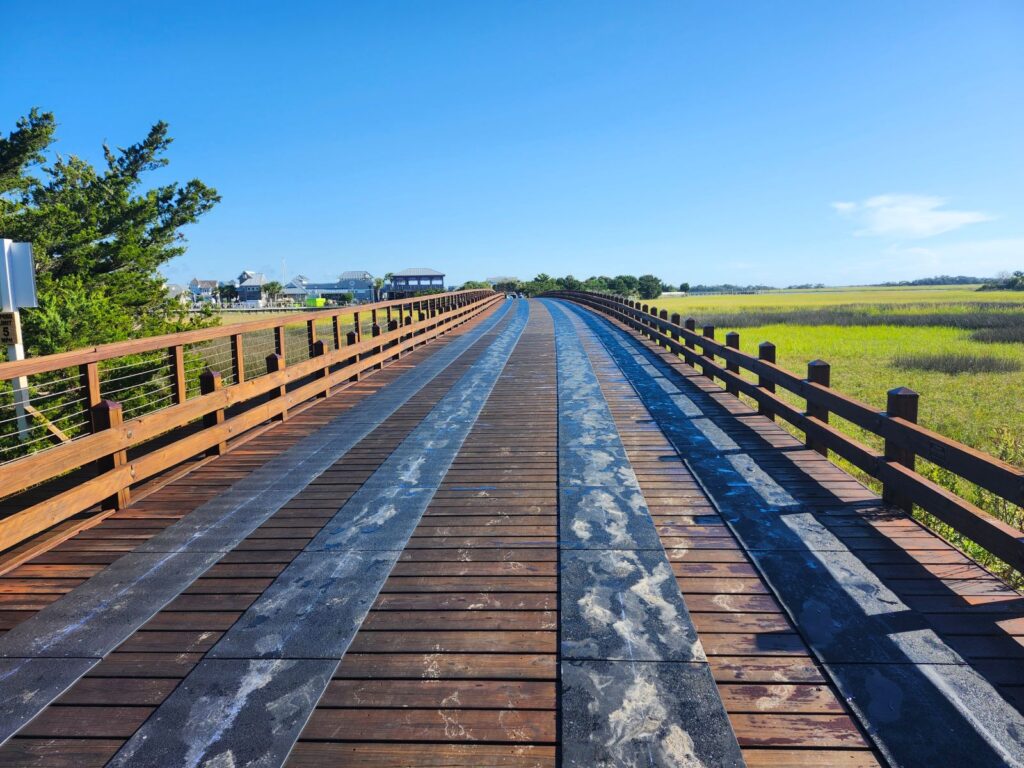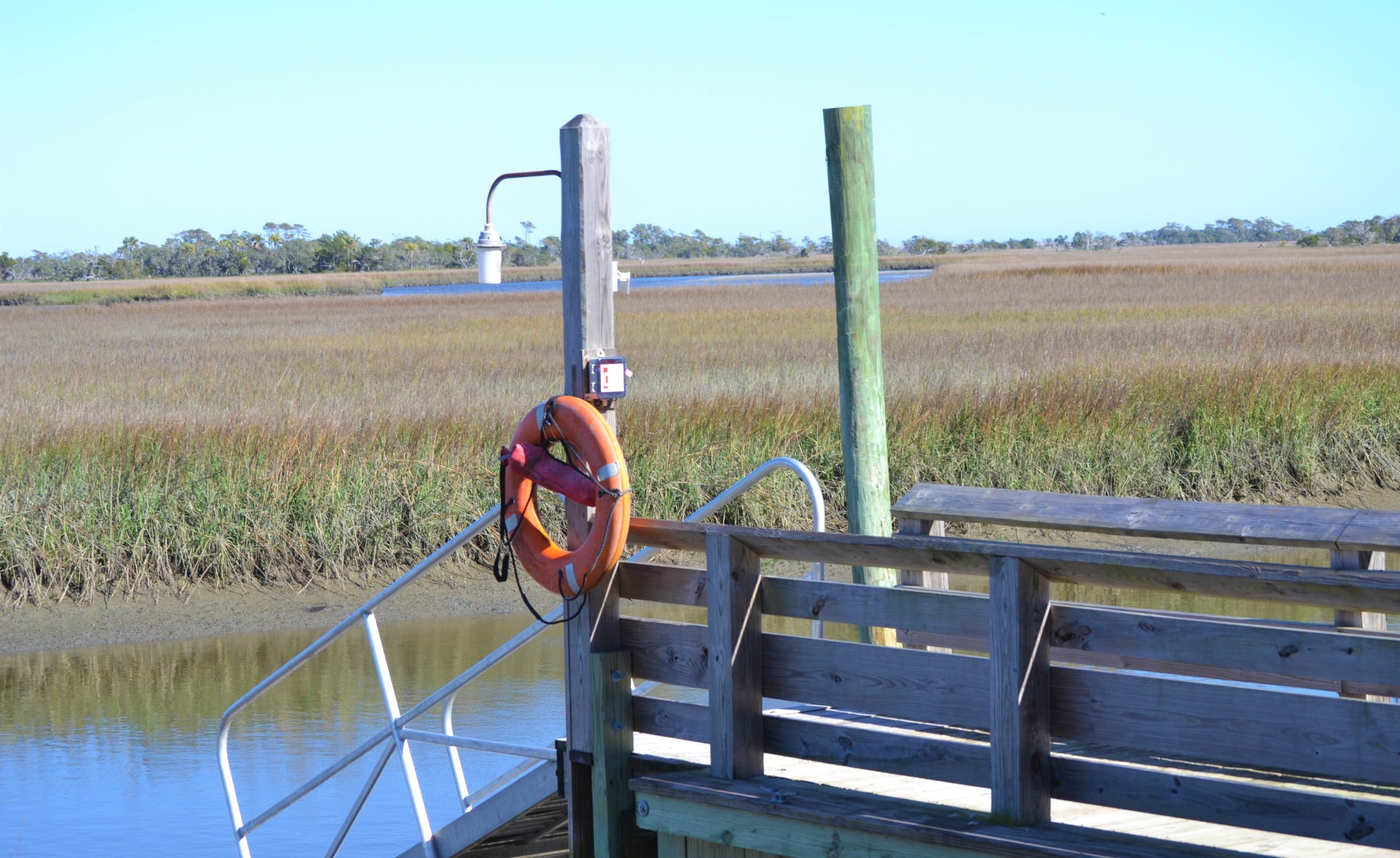Village Projects
Listed below are a few projects and initiatives that are taking place on Bald Head Island. More details can be found below, and additional information about these projects will be added as the status changes. Shoreline protection project information can be found HERE.
Current/Upcoming
- Fall 2025 Paving Project
- Contractor Services Improvements
- Overhead Tree Cutting
- Wastewater Treatment Plant Expansion Project
- Lift Station Maintenance Program
- Emerging Contaminants
- Accessible & Affordable Transportation System
- Wildlife Management
Recently Completed
- Radio Meter Read Project
- Timber Bridge Refurbishment & Wear Decking Installation
If you have a question about any of these projects or are not finding the information you need, please contact public.information@villagebhi.org.
Fall 2025 Paving Project
Village Staff is coordinating a planned Fall 2025 paving project as budgeted in the FY26 budget. The budget included $350,000 for a “large-scale” paving project to include sections of South Bald Head Wynd, Tanbark Court, and some patchwork in some needed areas on Edward Teach Extension (full list below). Note that historically, we have done these projects in the Fall, typically after we have gotten through most of hurricane season, at some point towards the end of October/early November, and before the full brunt of winter, given temperature requirements for laying asphalt.
This year, the work is scheduled for December 16 through 18, 2025. However, if the weather does not cooperate, the project will have to be pushed back to the first part of spring.
- Muscadine / S Bald Heady Wynd – 3” Mill & Pave – 1,500 SY
- S Bald Head Wynd 4” Asphalt Wedging – 150 SY
- Edward Teach Wynd Ext – 3” Mill & Pave – 110 SY (2 areas)
- Tanbark Ct. 2” Mill & Pave – 573 SY
- Tanbark Ct.: Concrete Header Curb Replacement – 35 LF
- Tanbark Ct: 4″ Concrete Sidewalk Replacement – 140 SF
Contractor Services Improvements
The Village continues to make improvements to the Contractor Services Lot. Parking spaces have been delineated to accommodate additional parking and to further narrow the waiting list for golf cart and ICE parking. The Village is considering adding a fee for golf cart charging.
Overhead Tree Cutting
Overhead tree cutting by the Village’s Contractor is scheduled to take place in December 2025 and February 2026. For more information about this routine maintenance, view our article HERE.
Beginning on November 17, Public Works will be performing tree maintenance. They will start at N Bald Head Wynd and Muscadine and will head west toward the marina. When they reach the end of N Bald Head Wynd, they will turn around and head east on the other side. There will be some lane closures during this time.
Wastewater Treatment Plant Expansion Project
This multi-year project has its own webpage. You can view it HERE.
What is going on with all the flags on the side of the road?
Some folks may have noticed that these flags have been around the island for quite some time. They are marking various utility lines for the infrastructure projects that have been on-going for several years (first the broadband fiber project and more recently the Duke Energy project). Please do not remove them.
At some point, ALL the flags will be removed, but not until all projects are completed. The Duke Energy project is complete, but the Village has a few other major projects, such as the Village’s stormwater management infrastructure
projects.
When all projects are completed, the Village can focus on the removal of the flags, which we agree are not the most attractive sight on the island, but are necessary to bring forth these planned improvements with minimal delay.
Lift Station Maintenance Program
The Village maintains 38 Wastewater (WW) Collection duplex lift stations, which range in horsepower from 20hp to 2hp. The Village contracts out this work and is using a phased approach. The funding for this work comes out of the Village’s Water & Sewer Fund, which is separated from the General Fund and uses revenues from utility fees.
HERE is a list of the proposed maintenance needs for this program.
The Village continues to evaluate the maintenance needs of its lift stations annually and budgets accordingly. At this time, there is no urgency to the maintenance; however, it should not be deferred for too long.
Question: Why is there an odor at Timbercreek?
The Primary Main is located at Timbercreek. After investigating the operation of this lift station, it was observed that the floats were not set low enough and the station was not turning over waste quickly. That has been addressed and has improved the odor, but it is still present at times. It should be much better in the off season. The Public Services Department is going to request funds in the FY25 budget to purchase equipment to address the issue long-term.
Emerging Contaminants
The Village’s Public Services Director, JP McCann has been attending NC Department of Environmental Quality (NCDEQ) workshops locally since 2021. The Village has taken advantage of opportunities to perform testing on the Village’s water and to apply for grant funding (Drinking Water State Revolving Fund) to lower/eliminate contaminants (PFAS). The testing results and background information can be found on the Village’s Emerging Contaminants webpage HERE.
Accessible & Affordable Transportation System
The Village took measures to ensure that the island’s interests are protected as the developer (Bald Head Island Limited) exits the island. All island stakeholders must have an accessible and affordable transportation system now and in the future. These efforts led to legal action by the Village and Limited. At the conclusion of the litigation, the Village Council indicated that it remains committed to supporting Limited in providing our community with the best possible transportation system. Toward this end, the Council will continue to engage with them and their successor.
Wildlife Management – Deer:
The Village has been monitoring the deer population through its annual environmental services contract with the Bald Head Island Conservancy dating back to the early 2000’s. The Conservancy performs spotlight surveys in the summer and uses cameras in the fall to track and estimate the deer population and makes management recommendations to the Village.
In the past, the Village has used a culling and/or a combination of culling and immunocontraception to manage the population. The immunocontraception program, the first of its kind in NC, was initiated on BHI by way of a research permit issued by the NC Wildlife Resources Commission (NCWRC) for 5 years beginning in 2014. The permit was extended for 2 years and was suspended in 2021 when the population fell below the target herd size of approximately 200 deer.
Since the population has increased, the Village will need to perform a cull in winter 2025/2026 to reduce the population. Consideration is being made to restart the immunocontraception program in late 2026/early 2027, but that remains to be seen as the Village Council continues to discuss pros, cons, and overall cost-benefit to the island.
Additional information and resources can be found on the Village’s Deer Management webpage HERE.
What are the green plastic safety fences in the maritime forest? These are exclosures to protect vegetation from deer. See more information about these on the BHI Conservancy website HERE. Several were damaged from recent hurricanes and staff with the Bald Head Woods Reserve are aware of this and are evaluating options (repair/replace/remove).
Coyote: During the 2019 turtle season, the Conservancy reported that coyotes were disturbing turtle nests and eating the eggs. Several non-lethal methods were used to deter the coyotes with little success. After consulting wildlife biologists about the viability of trapping coyotes, the Village and the Conservancy worked together to obtain a depredation permit. At this time, the Village currently has no plans in place to renew or use the permit. Please see the latest efforts the Conservancy is making in studying predator behavior on the shoreline HERE.
Recently Completed
Radio Meter Read Project
The Village recently completed the installation of new radio antennae at five locations on the island, which will provide remote, real-time readings from consumers’ water meters. The meter readings are collected at Village Hall, and the information is used for utility billing and to proactively monitor water flow, identifying leaks and water main breaks.
The project had been in progress for the last three years. This included extensive data collection to determine the best location to receive radio signals to read a majority of water meters on the island. The positioning of each antenna was data-driven and considered signal strength, connectivity to a power source and internet, and each had to be located on Village-owned property or utility right-of-way access.
Timber Bridge Refurbishment & Wear Deck Installation
The Village has been working to address longevity and safety of the Timber Bridge over the last several years.
Longevity – Over time, the Village stretched out the use of the timber boards as long as it could by flipping some of the damaged boards, staining and sealing regularly, and then fully replacing the most damaged ones.
The size of the boards is unique, and they must be special-ordered from one of the few vendors who can supply the specific size needed. After many of the existing boards could no longer be maintained, Village staff recommended full replacement, and the Village Council ultimately approved the replacement of all 800 boards in phases. Boards and screws alone for the replacement were about $150k.
Concurrently, the Village sought and received a CAMA permit from the NC Division of Coastal Management to install the wear decking. The wear decking will protect the boards from the extensive wear and damage that has been occurring. This will save Village taxpayers from frequent maintenance and replacement costs.

Safety – The wear decking is an HTPE anti-skid DOT pattern, it’s traffic-rated and textured. The stopping distance (the distance travelled while the driver notices a hazard and applies the brakes) has improved greatly with the installation of this material. This is important because both ends of the bridge have pedestrian crossings, and vehicles must be able to stop quickly. The bridge used to be very slick during rain events and is now safer with the new decking. The bridge is also very susceptible to accumulating ice, and the new black decking should speed up the thawing process, shortening the length of time the bridge is closed during a winter freeze.

